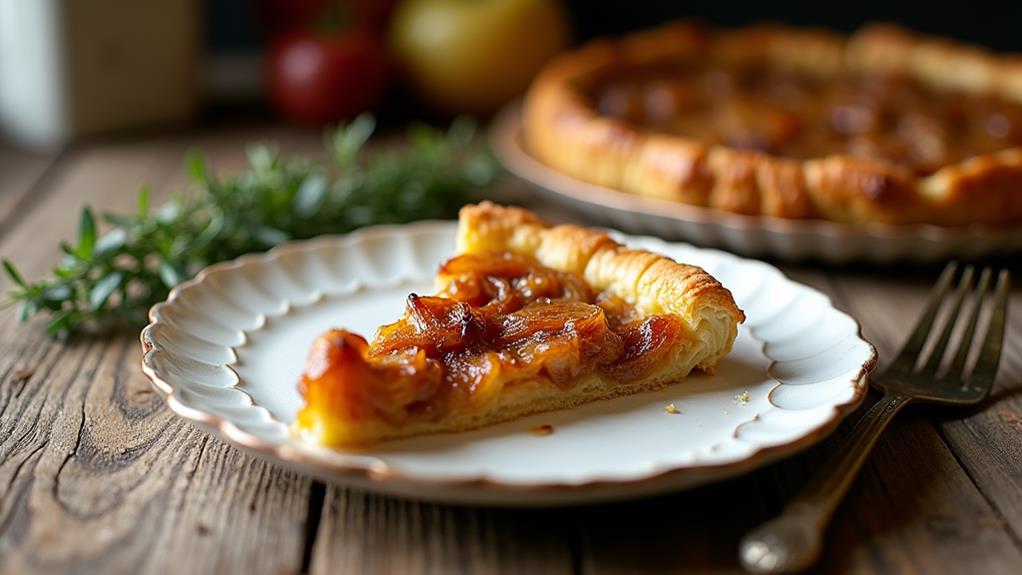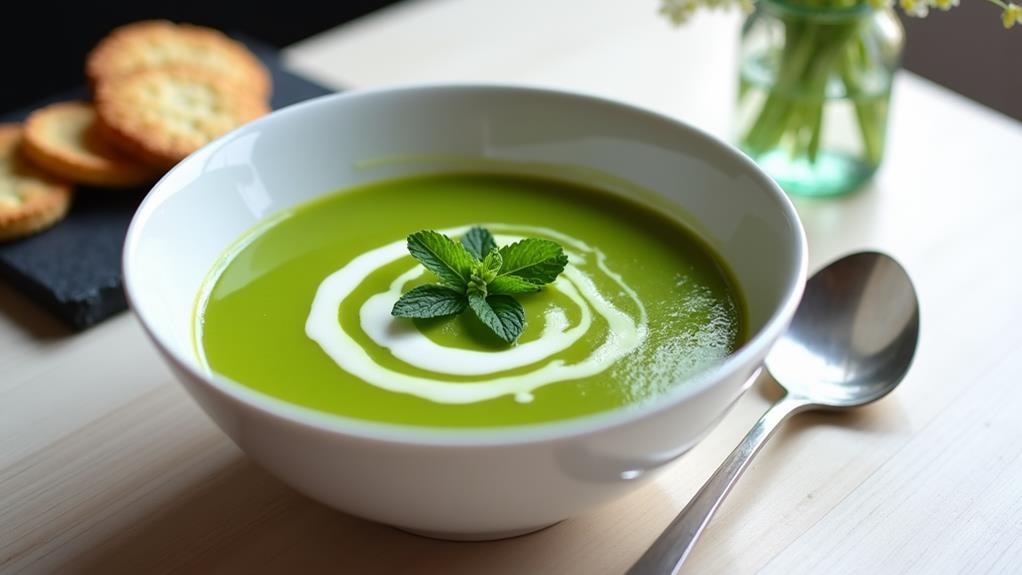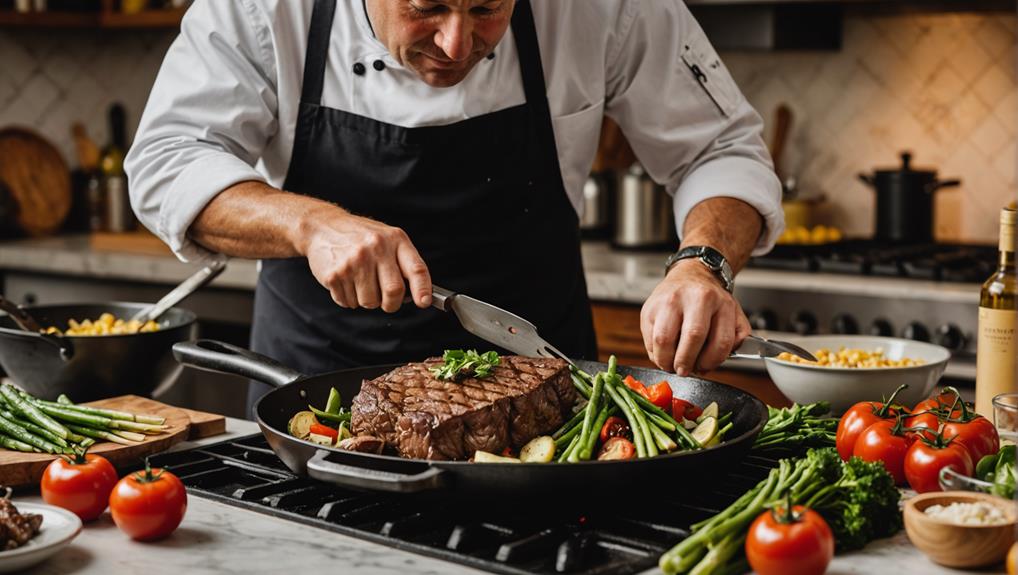You're about to discover a dish that combines simplicity with sophistication. The Caramelized Onion and Gruyère Tart is more than just a recipe; it's a journey through French culinary traditions. As you explore its history and learn the steps to create this savory masterpiece, you'll find yourself drawn into the world of slow-cooked onions and nutty cheese. But there's more to this tart than meets the eye. Its versatility and ease of preparation make it a go-to for both casual gatherings and elegant affairs. What secrets lie behind this seemingly humble dish? Let's uncover them together.
Key Takeaways
- Combines sweet caramelized onions with nutty Gruyère cheese on a puff pastry base.
- Requires only five ingredients: puff pastry, onions, butter, Gruyère cheese, and egg.
- Ideal for light lunch, appetizer, or sophisticated brunch spread.
- Originated from traditional French cuisine, evolving from quiche and gaining popularity in Parisian cafes.
- Best served warm or at room temperature, with a golden-brown crust and melty cheese topping.
History
The caramelized onion and Gruyère tart has its roots in traditional French cuisine. You'll find this savory pastry's origins in the rustic kitchens of rural France, where home cooks masterfully combined simple ingredients to create exquisite dishes.
The tart's evolution can be traced back to the quiche, a staple of French cooking that dates to the 16th century. As culinary techniques advanced, chefs began experimenting with different flavor combinations, leading to the creation of this elegant tart.
In the 19th century, as French cuisine gained international recognition, variations of the onion tart spread across Europe. The addition of Gruyère cheese, a Swiss specialty, reflects the culinary exchange between neighboring regions.
This fusion of flavors became popular in upscale Parisian cafes and bistros, cementing its status as a refined dish. Today, you'll find the caramelized onion and Gruyère tart on menus worldwide, from casual eateries to high-end restaurants.
Its enduring popularity is a testament to the timeless appeal of well-balanced flavors and the artistry of French cooking techniques.
Recipe
Caramelized onion and Gruyère tart is a delightful French dish that combines the sweet, rich flavor of slowly cooked onions with the nutty, savory taste of Gruyère cheese. This elegant tart is perfect for a light lunch, appetizer, or as part of a sophisticated brunch spread.
This simplified version focuses on the essential elements, allowing the flavors of the caramelized onions and Gruyère to shine. By using pre-made puff pastry, we can create a delicious tart with minimal effort and only five ingredients.
- 1 sheet frozen puff pastry, thawed (about 8 oz or 225g)
- 3 large onions, thinly sliced (about 3 cups or 450g)
- 2 tablespoons butter (30g)
- 1 cup grated Gruyère cheese (100g)
- 1 egg, beaten (for egg wash)
Preheat the oven to 400°F (200°C). In a large skillet, melt the butter over medium heat and add the sliced onions. Cook the onions slowly, stirring occasionally, for about 30-40 minutes until they're deeply caramelized and golden brown.
While the onions are cooking, roll out the puff pastry on a lightly floured surface and transfer it to a baking sheet. Score a 1-inch border around the edge of the pastry. Spread the caramelized onions evenly over the pastry, leaving the border uncovered. Sprinkle the grated Gruyère cheese over the onions. Brush the border with beaten egg.
Bake for 20-25 minutes, or until the pastry is golden brown and puffed. For best results, slice the onions as thinly as possible to ensure even caramelization. Be patient when caramelizing the onions; low and slow is key to developing their sweet flavor. If the onions start to stick to the pan, add a splash of water to deglaze.
Allow the tart to cool for a few minutes before slicing to let the cheese set slightly. This tart is best served warm or at room temperature and can be reheated gently in the oven if made ahead.
Cooking Steps
To create this delicious tart, you'll start by preheating your oven to 400°F and caramelizing the onions in butter until they're golden brown.
Next, you'll roll out the puff pastry, add the onions and cheese, and carefully brush the border with an egg wash.
Step 1. Preheat Oven to 400°F

Before you begin assembling your tart, it's crucial to preheat your oven to 400°F (200°C). This step ensures that your oven reaches the correct temperature before you're ready to bake, allowing for even cooking and proper browning of the pastry.
While your oven is heating up, you'll have time to prepare the other components of your tart. As you wait for the oven to reach the desired temperature, gather your ingredients and equipment. This is an excellent opportunity to slice your onions, grate the Gruyère cheese, and roll out the puff pastry.
Remember, a properly preheated oven is key to achieving that perfect golden-brown crust and melty cheese topping. If your oven has a preheat indicator, wait for it to signal that it's ready. If not, allow about 15 minutes for most ovens to reach 400°F.
Keep in mind that older ovens may take longer to preheat, so plan accordingly. By taking the time to preheat your oven correctly, you're setting yourself up for success with your caramelized onion and Gruyère tart.
Step 2. Caramelize Onions in Butter
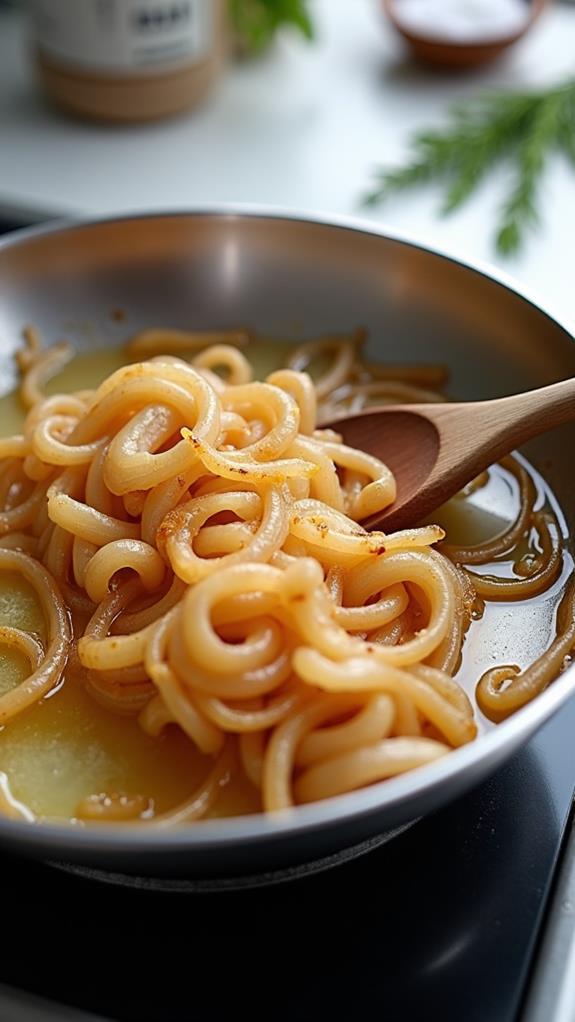
The onion-caramelizing process is a crucial step in creating the rich, sweet flavor base of your tart. Begin by melting two tablespoons of butter in a large skillet over medium heat.
Once the butter has melted, add your thinly sliced onions to the pan. You'll want to cook these slowly, stirring occasionally, for about 30-40 minutes. This patience is key to developing the onions' natural sweetness.
As the onions cook, they'll gradually turn a deep golden brown color. If you notice them sticking to the pan, don't worry. Simply add a small splash of water to deglaze the pan, which will help incorporate those flavorful browned bits back into the onions.
Keep a close eye on the heat, adjusting it as needed to prevent burning. You're aiming for a consistent, gentle cooking process that allows the onions to soften and caramelize evenly.
The result should be a tender, sweet, and deeply flavored onion mixture that'll form the heart of your tart. Once your onions have reached this perfect state, remove them from the heat and let them cool slightly before assembling your tart.
Step 3. Roll Out Puff Pastry

While your onions are caramelizing, it's time to prepare the pastry base for your tart. Begin by lightly flouring your work surface to prevent sticking.
Take your thawed puff pastry sheet and gently unfold it onto the floured area. Using a rolling pin, roll the pastry out to form a rectangle approximately 10 by 12 inches. This will give you enough surface area for your tart while maintaining a suitable thickness.
Once you've achieved the desired size, carefully transfer the rolled pastry to a baking sheet lined with parchment paper. To create a border that will puff up during baking, use a sharp knife to score a line about 1 inch from the edge all around the pastry.
Be careful not to cut all the way through; you're aiming for a shallow groove. This scored border will help contain your filling and create an attractive edge.
After scoring, use a fork to prick the inner portion of the pastry several times. This step, called docking, prevents the center from puffing up excessively during baking, ensuring a flat surface for your onions and cheese.
Step 4. Add Onions and Cheese
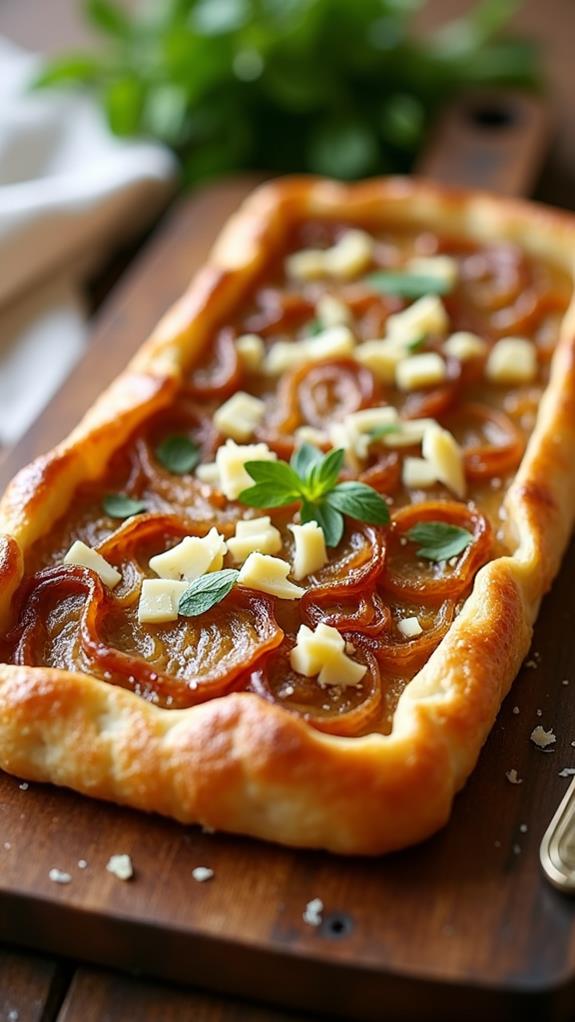
Once your onions have caramelized to a deep golden brown, it's time to assemble the tart. Remove the onions from the heat and let them cool slightly while you prepare the pastry.
Take your rolled-out puff pastry and carefully transfer it to a baking sheet lined with parchment paper. Using a sharp knife, score a border about an inch from the edge of the pastry, creating a frame for your toppings. Don't cut all the way through; you're just marking a guideline.
Now, spread the caramelized onions evenly over the pastry, leaving the scored border uncovered. This will allow the edges to puff up and create a lovely golden crust.
Next, sprinkle the grated Gruyère cheese over the onions, distributing it uniformly to ensure every bite has a perfect balance of flavors. Don't be tempted to overload the tart; a thin layer of toppings will yield the best results.
Step 5. Brush Border With Egg Wash
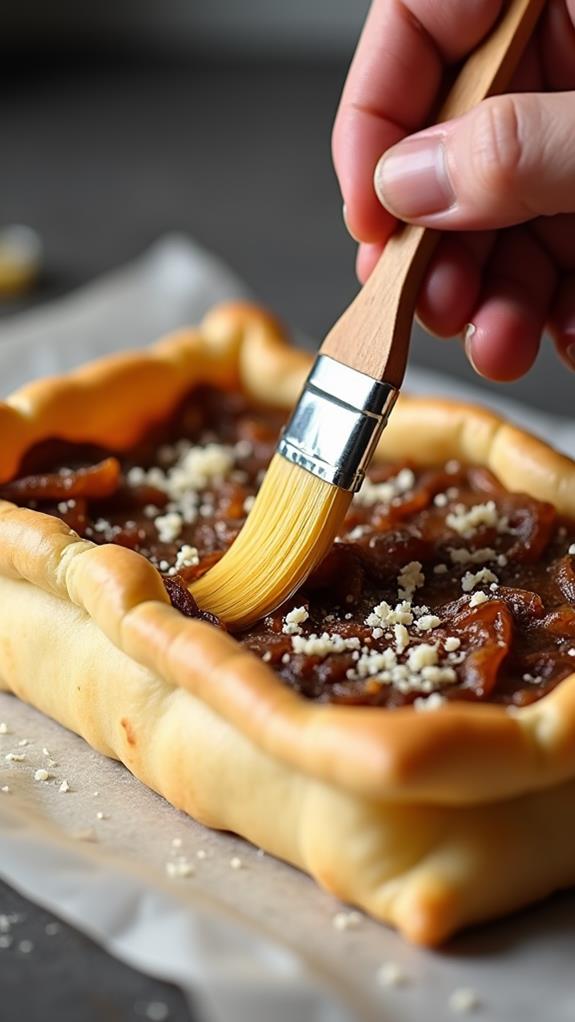
Brushing the tart's border with egg wash is a crucial final step before baking. This technique not only adds a beautiful golden sheen to your pastry but also helps seal the edges, preventing them from separating during cooking.
To create the egg wash, simply beat one egg in a small bowl until it's well combined. Then, using a pastry brush, carefully apply a thin, even layer of the beaten egg to the 1-inch border you've scored around the edge of the pastry.
Be sure to cover the entire border, but avoid letting the egg wash drip onto the baking sheet, as this can cause the pastry to stick. If you don't have a pastry brush, you can use a clean finger or a folded piece of parchment paper to apply the egg wash.
For an extra touch of elegance, you can sprinkle a pinch of flaky sea salt or some freshly ground black pepper on the egg-washed border before baking. This final step will ensure your caramelized onion and Gruyère tart emerges from the oven with a beautifully golden, crisp crust that's as visually appealing as it's delicious.
Final Thoughts
This caramelized onion and Gruyère tart is a testament to the beauty of simple, quality ingredients.
You'll find that the combination of sweet, caramelized onions and nutty Gruyère cheese creates a harmonious blend of flavors that's both comforting and sophisticated.
Don't be afraid to experiment with different cheeses or add herbs like thyme or rosemary to customize the tart to your taste.

